Understanding Why People Work: Factors and Strategies for Motivation
VerifiedAdded on 2023/06/17
|8
|2093
|288
AI Summary
This report discusses the concept of motivation and factors through which employees get motivated. It further analyses the positive and negative factors that employees experience due to their roles in job along with providing the strategies to cope with inferior aspects.
Contribute Materials
Your contribution can guide someone’s learning journey. Share your
documents today.
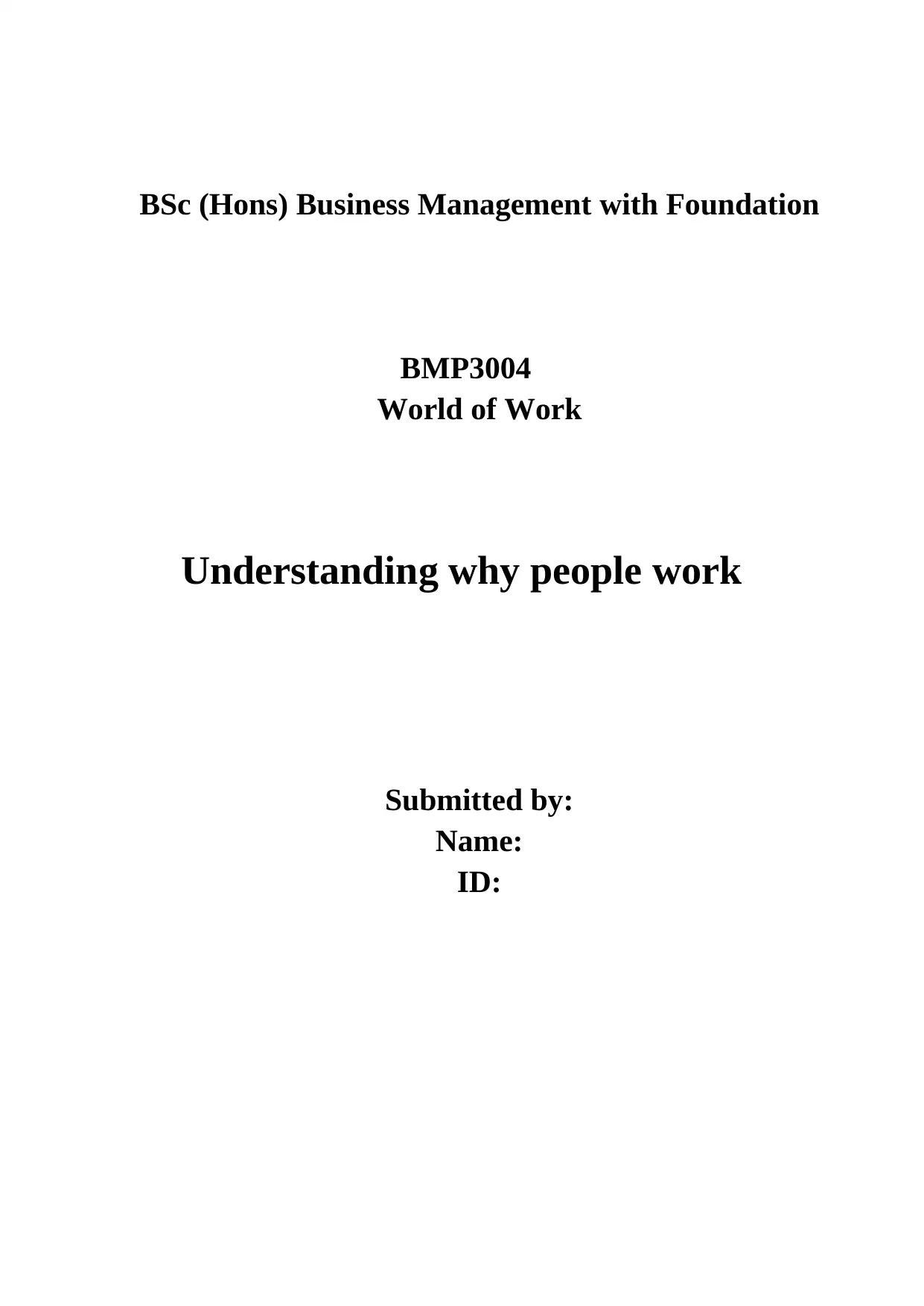
BSc (Hons) Business Management with Foundation
BMP3004
World of Work
Understanding why people work
Submitted by:
Name:
ID:
BMP3004
World of Work
Understanding why people work
Submitted by:
Name:
ID:
Secure Best Marks with AI Grader
Need help grading? Try our AI Grader for instant feedback on your assignments.
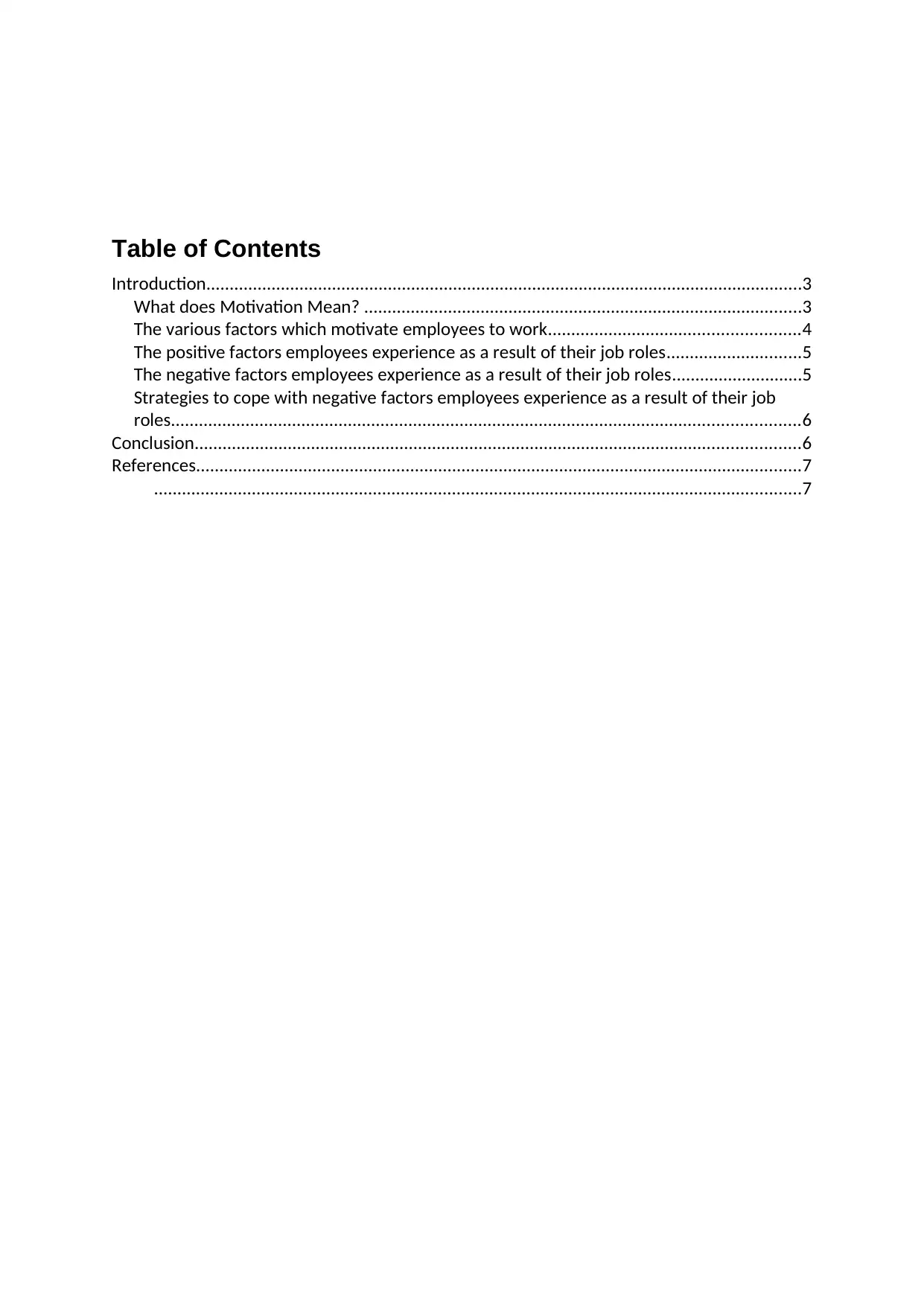
Table of Contents
Introduction................................................................................................................................3
What does Motivation Mean? ..............................................................................................3
The various factors which motivate employees to work......................................................4
The positive factors employees experience as a result of their job roles.............................5
The negative factors employees experience as a result of their job roles............................5
Strategies to cope with negative factors employees experience as a result of their job
roles.......................................................................................................................................6
Conclusion..................................................................................................................................6
References..................................................................................................................................7
...........................................................................................................................................7
Introduction................................................................................................................................3
What does Motivation Mean? ..............................................................................................3
The various factors which motivate employees to work......................................................4
The positive factors employees experience as a result of their job roles.............................5
The negative factors employees experience as a result of their job roles............................5
Strategies to cope with negative factors employees experience as a result of their job
roles.......................................................................................................................................6
Conclusion..................................................................................................................................6
References..................................................................................................................................7
...........................................................................................................................................7
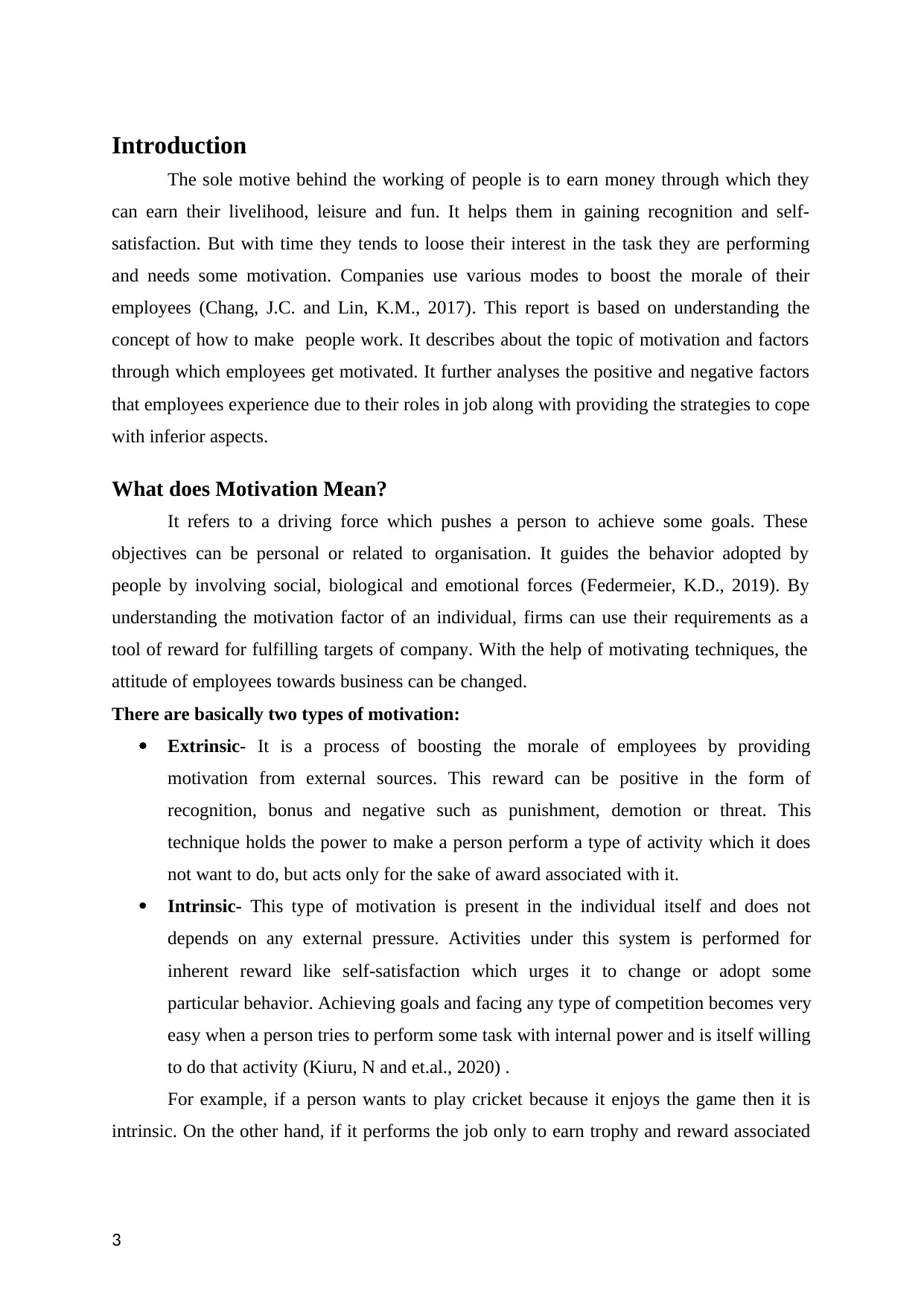
Introduction
The sole motive behind the working of people is to earn money through which they
can earn their livelihood, leisure and fun. It helps them in gaining recognition and self-
satisfaction. But with time they tends to loose their interest in the task they are performing
and needs some motivation. Companies use various modes to boost the morale of their
employees (Chang, J.C. and Lin, K.M., 2017). This report is based on understanding the
concept of how to make people work. It describes about the topic of motivation and factors
through which employees get motivated. It further analyses the positive and negative factors
that employees experience due to their roles in job along with providing the strategies to cope
with inferior aspects.
What does Motivation Mean?
It refers to a driving force which pushes a person to achieve some goals. These
objectives can be personal or related to organisation. It guides the behavior adopted by
people by involving social, biological and emotional forces (Federmeier, K.D., 2019). By
understanding the motivation factor of an individual, firms can use their requirements as a
tool of reward for fulfilling targets of company. With the help of motivating techniques, the
attitude of employees towards business can be changed.
There are basically two types of motivation:
Extrinsic- It is a process of boosting the morale of employees by providing
motivation from external sources. This reward can be positive in the form of
recognition, bonus and negative such as punishment, demotion or threat. This
technique holds the power to make a person perform a type of activity which it does
not want to do, but acts only for the sake of award associated with it.
Intrinsic- This type of motivation is present in the individual itself and does not
depends on any external pressure. Activities under this system is performed for
inherent reward like self-satisfaction which urges it to change or adopt some
particular behavior. Achieving goals and facing any type of competition becomes very
easy when a person tries to perform some task with internal power and is itself willing
to do that activity (Kiuru, N and et.al., 2020) .
For example, if a person wants to play cricket because it enjoys the game then it is
intrinsic. On the other hand, if it performs the job only to earn trophy and reward associated
3
The sole motive behind the working of people is to earn money through which they
can earn their livelihood, leisure and fun. It helps them in gaining recognition and self-
satisfaction. But with time they tends to loose their interest in the task they are performing
and needs some motivation. Companies use various modes to boost the morale of their
employees (Chang, J.C. and Lin, K.M., 2017). This report is based on understanding the
concept of how to make people work. It describes about the topic of motivation and factors
through which employees get motivated. It further analyses the positive and negative factors
that employees experience due to their roles in job along with providing the strategies to cope
with inferior aspects.
What does Motivation Mean?
It refers to a driving force which pushes a person to achieve some goals. These
objectives can be personal or related to organisation. It guides the behavior adopted by
people by involving social, biological and emotional forces (Federmeier, K.D., 2019). By
understanding the motivation factor of an individual, firms can use their requirements as a
tool of reward for fulfilling targets of company. With the help of motivating techniques, the
attitude of employees towards business can be changed.
There are basically two types of motivation:
Extrinsic- It is a process of boosting the morale of employees by providing
motivation from external sources. This reward can be positive in the form of
recognition, bonus and negative such as punishment, demotion or threat. This
technique holds the power to make a person perform a type of activity which it does
not want to do, but acts only for the sake of award associated with it.
Intrinsic- This type of motivation is present in the individual itself and does not
depends on any external pressure. Activities under this system is performed for
inherent reward like self-satisfaction which urges it to change or adopt some
particular behavior. Achieving goals and facing any type of competition becomes very
easy when a person tries to perform some task with internal power and is itself willing
to do that activity (Kiuru, N and et.al., 2020) .
For example, if a person wants to play cricket because it enjoys the game then it is
intrinsic. On the other hand, if it performs the job only to earn trophy and reward associated
3
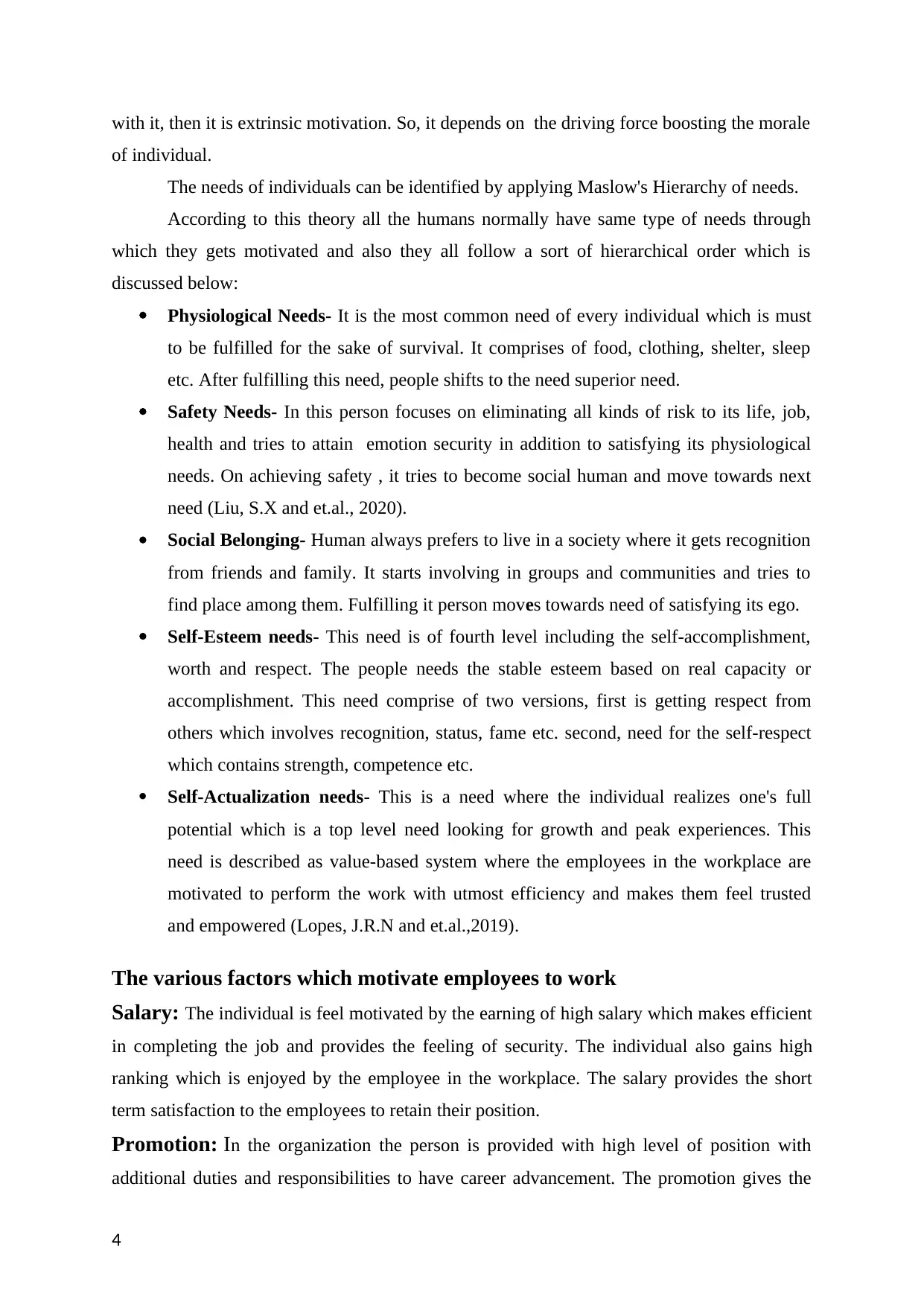
with it, then it is extrinsic motivation. So, it depends on the driving force boosting the morale
of individual.
The needs of individuals can be identified by applying Maslow's Hierarchy of needs.
According to this theory all the humans normally have same type of needs through
which they gets motivated and also they all follow a sort of hierarchical order which is
discussed below:
Physiological Needs- It is the most common need of every individual which is must
to be fulfilled for the sake of survival. It comprises of food, clothing, shelter, sleep
etc. After fulfilling this need, people shifts to the need superior need.
Safety Needs- In this person focuses on eliminating all kinds of risk to its life, job,
health and tries to attain emotion security in addition to satisfying its physiological
needs. On achieving safety , it tries to become social human and move towards next
need (Liu, S.X and et.al., 2020).
Social Belonging- Human always prefers to live in a society where it gets recognition
from friends and family. It starts involving in groups and communities and tries to
find place among them. Fulfilling it person moves towards need of satisfying its ego.
Self-Esteem needs- This need is of fourth level including the self-accomplishment,
worth and respect. The people needs the stable esteem based on real capacity or
accomplishment. This need comprise of two versions, first is getting respect from
others which involves recognition, status, fame etc. second, need for the self-respect
which contains strength, competence etc.
Self-Actualization needs- This is a need where the individual realizes one's full
potential which is a top level need looking for growth and peak experiences. This
need is described as value-based system where the employees in the workplace are
motivated to perform the work with utmost efficiency and makes them feel trusted
and empowered (Lopes, J.R.N and et.al.,2019).
The various factors which motivate employees to work
Salary: The individual is feel motivated by the earning of high salary which makes efficient
in completing the job and provides the feeling of security. The individual also gains high
ranking which is enjoyed by the employee in the workplace. The salary provides the short
term satisfaction to the employees to retain their position.
Promotion: In the organization the person is provided with high level of position with
additional duties and responsibilities to have career advancement. The promotion gives the
4
of individual.
The needs of individuals can be identified by applying Maslow's Hierarchy of needs.
According to this theory all the humans normally have same type of needs through
which they gets motivated and also they all follow a sort of hierarchical order which is
discussed below:
Physiological Needs- It is the most common need of every individual which is must
to be fulfilled for the sake of survival. It comprises of food, clothing, shelter, sleep
etc. After fulfilling this need, people shifts to the need superior need.
Safety Needs- In this person focuses on eliminating all kinds of risk to its life, job,
health and tries to attain emotion security in addition to satisfying its physiological
needs. On achieving safety , it tries to become social human and move towards next
need (Liu, S.X and et.al., 2020).
Social Belonging- Human always prefers to live in a society where it gets recognition
from friends and family. It starts involving in groups and communities and tries to
find place among them. Fulfilling it person moves towards need of satisfying its ego.
Self-Esteem needs- This need is of fourth level including the self-accomplishment,
worth and respect. The people needs the stable esteem based on real capacity or
accomplishment. This need comprise of two versions, first is getting respect from
others which involves recognition, status, fame etc. second, need for the self-respect
which contains strength, competence etc.
Self-Actualization needs- This is a need where the individual realizes one's full
potential which is a top level need looking for growth and peak experiences. This
need is described as value-based system where the employees in the workplace are
motivated to perform the work with utmost efficiency and makes them feel trusted
and empowered (Lopes, J.R.N and et.al.,2019).
The various factors which motivate employees to work
Salary: The individual is feel motivated by the earning of high salary which makes efficient
in completing the job and provides the feeling of security. The individual also gains high
ranking which is enjoyed by the employee in the workplace. The salary provides the short
term satisfaction to the employees to retain their position.
Promotion: In the organization the person is provided with high level of position with
additional duties and responsibilities to have career advancement. The promotion gives the
4
Secure Best Marks with AI Grader
Need help grading? Try our AI Grader for instant feedback on your assignments.
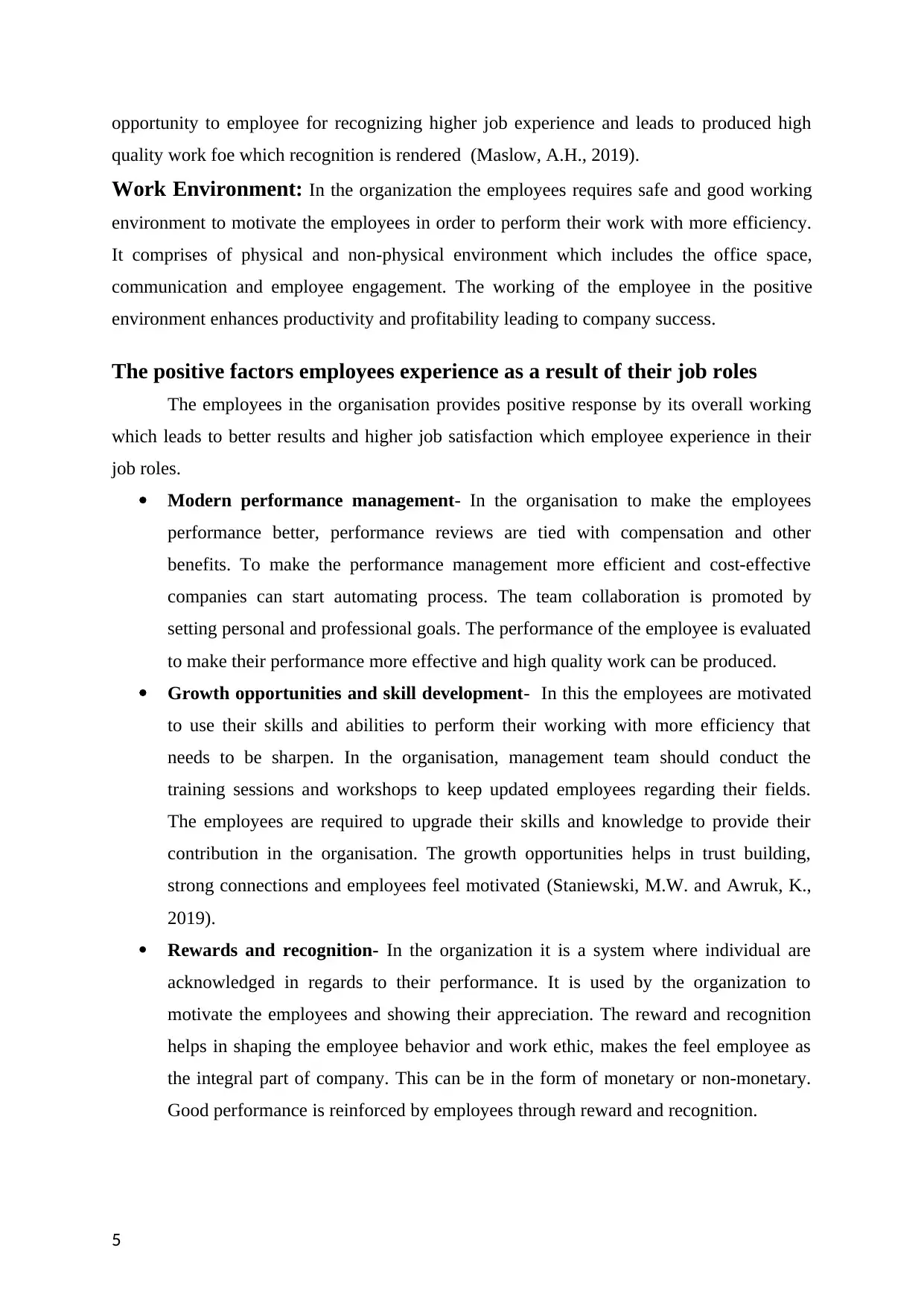
opportunity to employee for recognizing higher job experience and leads to produced high
quality work foe which recognition is rendered (Maslow, A.H., 2019).
Work Environment: In the organization the employees requires safe and good working
environment to motivate the employees in order to perform their work with more efficiency.
It comprises of physical and non-physical environment which includes the office space,
communication and employee engagement. The working of the employee in the positive
environment enhances productivity and profitability leading to company success.
The positive factors employees experience as a result of their job roles
The employees in the organisation provides positive response by its overall working
which leads to better results and higher job satisfaction which employee experience in their
job roles.
Modern performance management- In the organisation to make the employees
performance better, performance reviews are tied with compensation and other
benefits. To make the performance management more efficient and cost-effective
companies can start automating process. The team collaboration is promoted by
setting personal and professional goals. The performance of the employee is evaluated
to make their performance more effective and high quality work can be produced.
Growth opportunities and skill development- In this the employees are motivated
to use their skills and abilities to perform their working with more efficiency that
needs to be sharpen. In the organisation, management team should conduct the
training sessions and workshops to keep updated employees regarding their fields.
The employees are required to upgrade their skills and knowledge to provide their
contribution in the organisation. The growth opportunities helps in trust building,
strong connections and employees feel motivated (Staniewski, M.W. and Awruk, K.,
2019).
Rewards and recognition- In the organization it is a system where individual are
acknowledged in regards to their performance. It is used by the organization to
motivate the employees and showing their appreciation. The reward and recognition
helps in shaping the employee behavior and work ethic, makes the feel employee as
the integral part of company. This can be in the form of monetary or non-monetary.
Good performance is reinforced by employees through reward and recognition.
5
quality work foe which recognition is rendered (Maslow, A.H., 2019).
Work Environment: In the organization the employees requires safe and good working
environment to motivate the employees in order to perform their work with more efficiency.
It comprises of physical and non-physical environment which includes the office space,
communication and employee engagement. The working of the employee in the positive
environment enhances productivity and profitability leading to company success.
The positive factors employees experience as a result of their job roles
The employees in the organisation provides positive response by its overall working
which leads to better results and higher job satisfaction which employee experience in their
job roles.
Modern performance management- In the organisation to make the employees
performance better, performance reviews are tied with compensation and other
benefits. To make the performance management more efficient and cost-effective
companies can start automating process. The team collaboration is promoted by
setting personal and professional goals. The performance of the employee is evaluated
to make their performance more effective and high quality work can be produced.
Growth opportunities and skill development- In this the employees are motivated
to use their skills and abilities to perform their working with more efficiency that
needs to be sharpen. In the organisation, management team should conduct the
training sessions and workshops to keep updated employees regarding their fields.
The employees are required to upgrade their skills and knowledge to provide their
contribution in the organisation. The growth opportunities helps in trust building,
strong connections and employees feel motivated (Staniewski, M.W. and Awruk, K.,
2019).
Rewards and recognition- In the organization it is a system where individual are
acknowledged in regards to their performance. It is used by the organization to
motivate the employees and showing their appreciation. The reward and recognition
helps in shaping the employee behavior and work ethic, makes the feel employee as
the integral part of company. This can be in the form of monetary or non-monetary.
Good performance is reinforced by employees through reward and recognition.
5
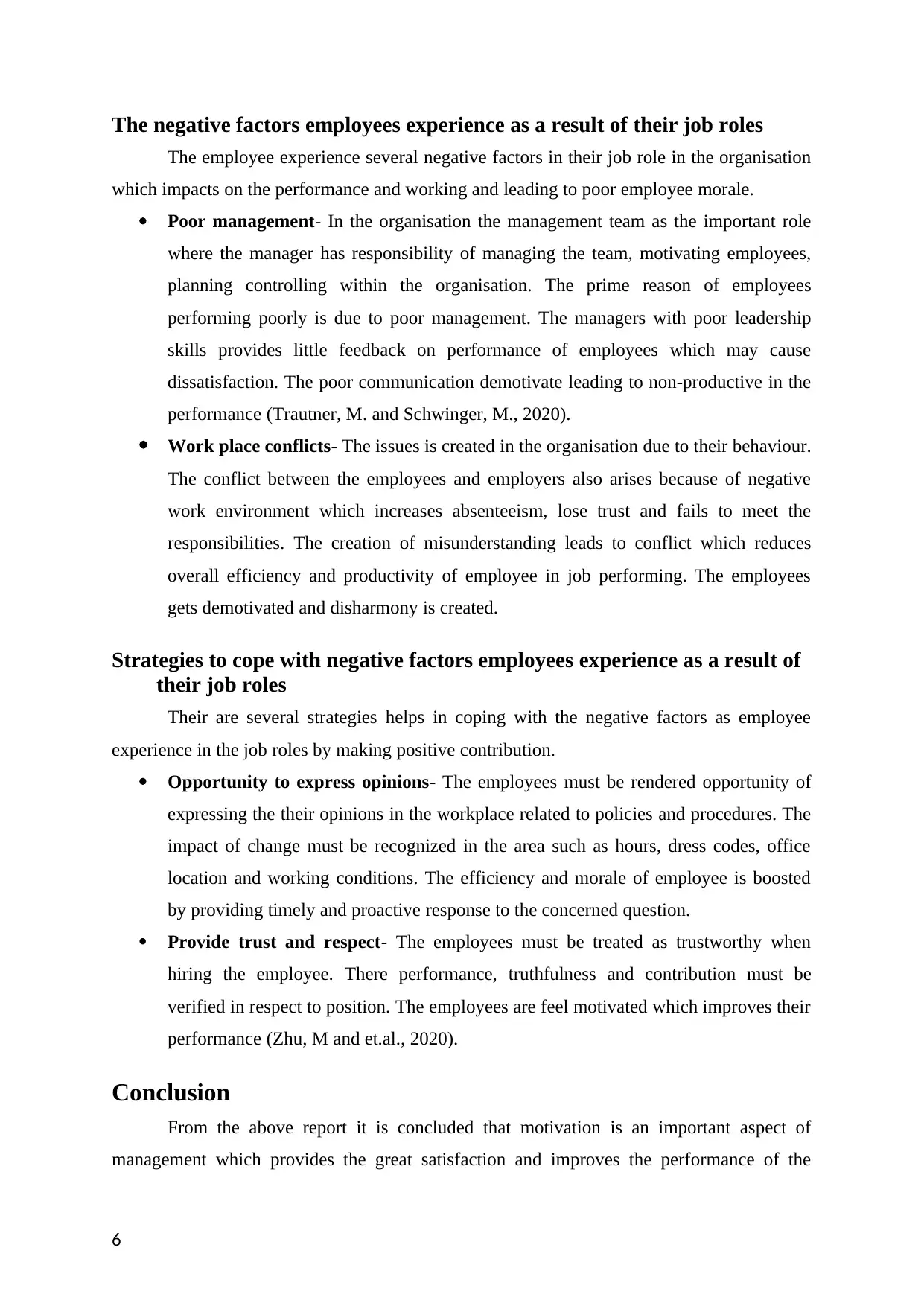
The negative factors employees experience as a result of their job roles
The employee experience several negative factors in their job role in the organisation
which impacts on the performance and working and leading to poor employee morale.
Poor management- In the organisation the management team as the important role
where the manager has responsibility of managing the team, motivating employees,
planning controlling within the organisation. The prime reason of employees
performing poorly is due to poor management. The managers with poor leadership
skills provides little feedback on performance of employees which may cause
dissatisfaction. The poor communication demotivate leading to non-productive in the
performance (Trautner, M. and Schwinger, M., 2020).
Work place conflicts- The issues is created in the organisation due to their behaviour.
The conflict between the employees and employers also arises because of negative
work environment which increases absenteeism, lose trust and fails to meet the
responsibilities. The creation of misunderstanding leads to conflict which reduces
overall efficiency and productivity of employee in job performing. The employees
gets demotivated and disharmony is created.
Strategies to cope with negative factors employees experience as a result of
their job roles
Their are several strategies helps in coping with the negative factors as employee
experience in the job roles by making positive contribution.
Opportunity to express opinions- The employees must be rendered opportunity of
expressing the their opinions in the workplace related to policies and procedures. The
impact of change must be recognized in the area such as hours, dress codes, office
location and working conditions. The efficiency and morale of employee is boosted
by providing timely and proactive response to the concerned question.
Provide trust and respect- The employees must be treated as trustworthy when
hiring the employee. There performance, truthfulness and contribution must be
verified in respect to position. The employees are feel motivated which improves their
performance (Zhu, M and et.al., 2020).
Conclusion
From the above report it is concluded that motivation is an important aspect of
management which provides the great satisfaction and improves the performance of the
6
The employee experience several negative factors in their job role in the organisation
which impacts on the performance and working and leading to poor employee morale.
Poor management- In the organisation the management team as the important role
where the manager has responsibility of managing the team, motivating employees,
planning controlling within the organisation. The prime reason of employees
performing poorly is due to poor management. The managers with poor leadership
skills provides little feedback on performance of employees which may cause
dissatisfaction. The poor communication demotivate leading to non-productive in the
performance (Trautner, M. and Schwinger, M., 2020).
Work place conflicts- The issues is created in the organisation due to their behaviour.
The conflict between the employees and employers also arises because of negative
work environment which increases absenteeism, lose trust and fails to meet the
responsibilities. The creation of misunderstanding leads to conflict which reduces
overall efficiency and productivity of employee in job performing. The employees
gets demotivated and disharmony is created.
Strategies to cope with negative factors employees experience as a result of
their job roles
Their are several strategies helps in coping with the negative factors as employee
experience in the job roles by making positive contribution.
Opportunity to express opinions- The employees must be rendered opportunity of
expressing the their opinions in the workplace related to policies and procedures. The
impact of change must be recognized in the area such as hours, dress codes, office
location and working conditions. The efficiency and morale of employee is boosted
by providing timely and proactive response to the concerned question.
Provide trust and respect- The employees must be treated as trustworthy when
hiring the employee. There performance, truthfulness and contribution must be
verified in respect to position. The employees are feel motivated which improves their
performance (Zhu, M and et.al., 2020).
Conclusion
From the above report it is concluded that motivation is an important aspect of
management which provides the great satisfaction and improves the performance of the
6
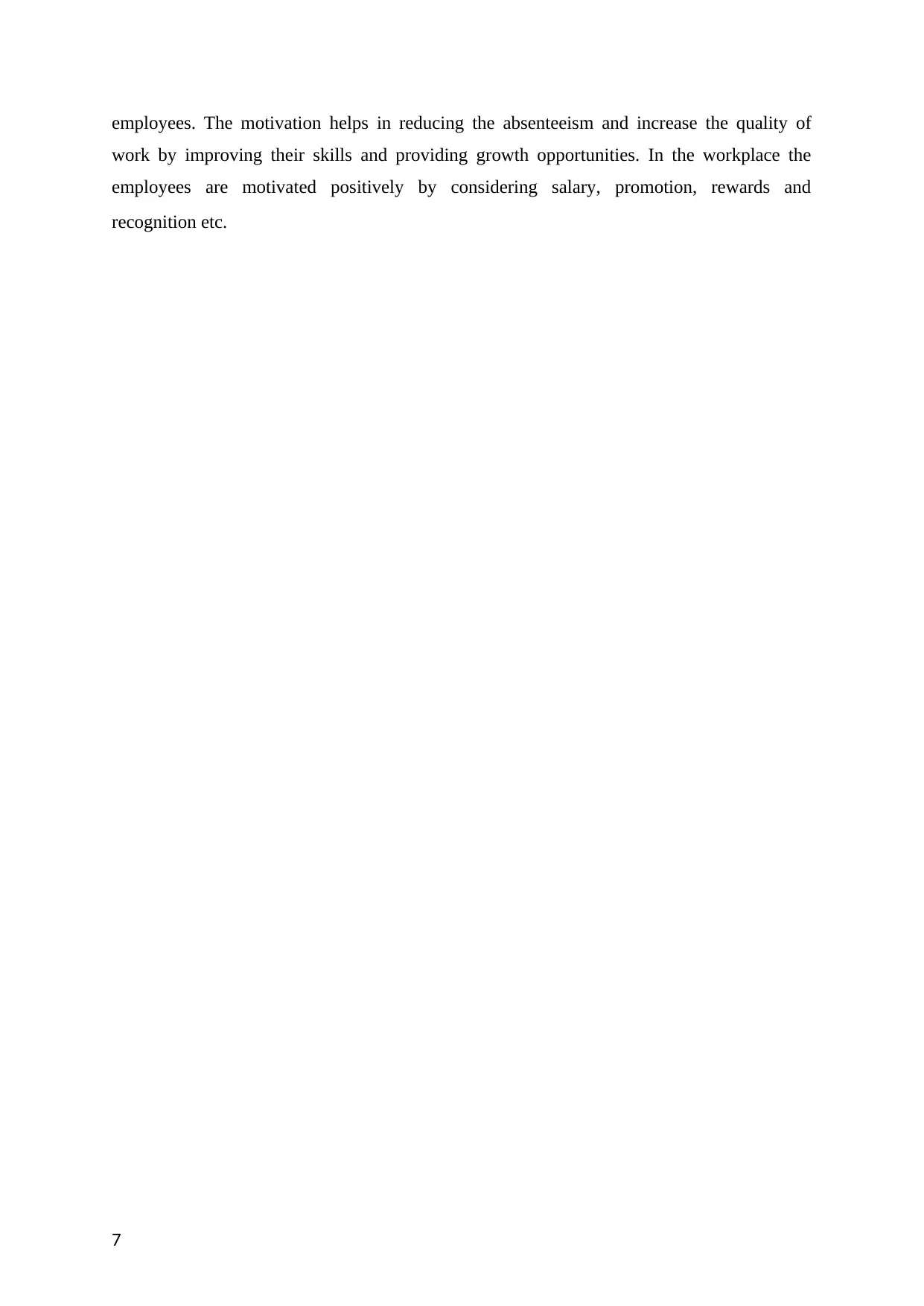
employees. The motivation helps in reducing the absenteeism and increase the quality of
work by improving their skills and providing growth opportunities. In the workplace the
employees are motivated positively by considering salary, promotion, rewards and
recognition etc.
7
work by improving their skills and providing growth opportunities. In the workplace the
employees are motivated positively by considering salary, promotion, rewards and
recognition etc.
7
Paraphrase This Document
Need a fresh take? Get an instant paraphrase of this document with our AI Paraphraser
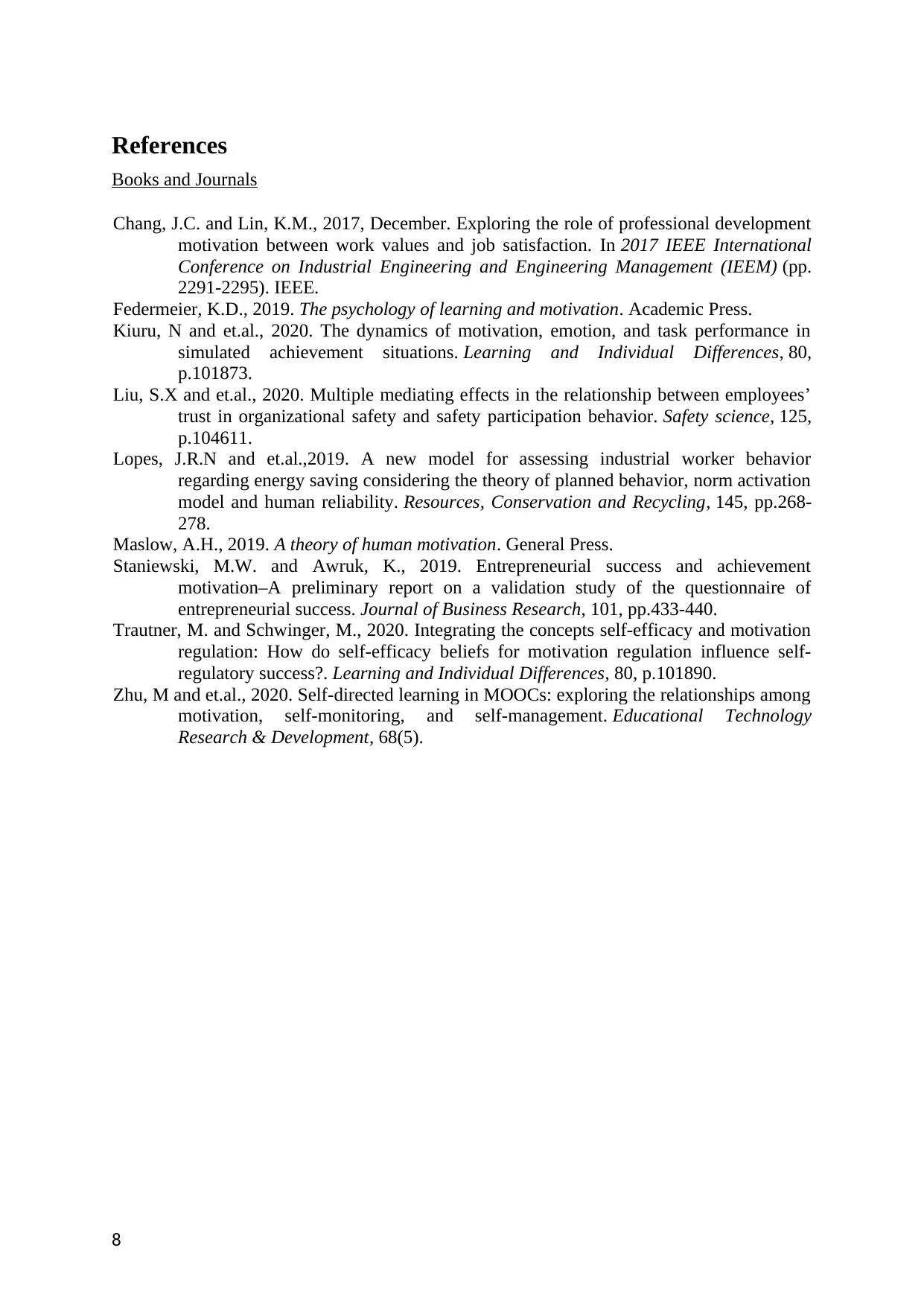
References
Books and Journals
Chang, J.C. and Lin, K.M., 2017, December. Exploring the role of professional development
motivation between work values and job satisfaction. In 2017 IEEE International
Conference on Industrial Engineering and Engineering Management (IEEM) (pp.
2291-2295). IEEE.
Federmeier, K.D., 2019. The psychology of learning and motivation. Academic Press.
Kiuru, N and et.al., 2020. The dynamics of motivation, emotion, and task performance in
simulated achievement situations. Learning and Individual Differences, 80,
p.101873.
Liu, S.X and et.al., 2020. Multiple mediating effects in the relationship between employees’
trust in organizational safety and safety participation behavior. Safety science, 125,
p.104611.
Lopes, J.R.N and et.al.,2019. A new model for assessing industrial worker behavior
regarding energy saving considering the theory of planned behavior, norm activation
model and human reliability. Resources, Conservation and Recycling, 145, pp.268-
278.
Maslow, A.H., 2019. A theory of human motivation. General Press.
Staniewski, M.W. and Awruk, K., 2019. Entrepreneurial success and achievement
motivation–A preliminary report on a validation study of the questionnaire of
entrepreneurial success. Journal of Business Research, 101, pp.433-440.
Trautner, M. and Schwinger, M., 2020. Integrating the concepts self-efficacy and motivation
regulation: How do self-efficacy beliefs for motivation regulation influence self-
regulatory success?. Learning and Individual Differences, 80, p.101890.
Zhu, M and et.al., 2020. Self-directed learning in MOOCs: exploring the relationships among
motivation, self-monitoring, and self-management. Educational Technology
Research & Development, 68(5).
8
Books and Journals
Chang, J.C. and Lin, K.M., 2017, December. Exploring the role of professional development
motivation between work values and job satisfaction. In 2017 IEEE International
Conference on Industrial Engineering and Engineering Management (IEEM) (pp.
2291-2295). IEEE.
Federmeier, K.D., 2019. The psychology of learning and motivation. Academic Press.
Kiuru, N and et.al., 2020. The dynamics of motivation, emotion, and task performance in
simulated achievement situations. Learning and Individual Differences, 80,
p.101873.
Liu, S.X and et.al., 2020. Multiple mediating effects in the relationship between employees’
trust in organizational safety and safety participation behavior. Safety science, 125,
p.104611.
Lopes, J.R.N and et.al.,2019. A new model for assessing industrial worker behavior
regarding energy saving considering the theory of planned behavior, norm activation
model and human reliability. Resources, Conservation and Recycling, 145, pp.268-
278.
Maslow, A.H., 2019. A theory of human motivation. General Press.
Staniewski, M.W. and Awruk, K., 2019. Entrepreneurial success and achievement
motivation–A preliminary report on a validation study of the questionnaire of
entrepreneurial success. Journal of Business Research, 101, pp.433-440.
Trautner, M. and Schwinger, M., 2020. Integrating the concepts self-efficacy and motivation
regulation: How do self-efficacy beliefs for motivation regulation influence self-
regulatory success?. Learning and Individual Differences, 80, p.101890.
Zhu, M and et.al., 2020. Self-directed learning in MOOCs: exploring the relationships among
motivation, self-monitoring, and self-management. Educational Technology
Research & Development, 68(5).
8
1 out of 8
Related Documents
Your All-in-One AI-Powered Toolkit for Academic Success.
+13062052269
info@desklib.com
Available 24*7 on WhatsApp / Email
![[object Object]](/_next/static/media/star-bottom.7253800d.svg)
Unlock your academic potential
© 2024 | Zucol Services PVT LTD | All rights reserved.



